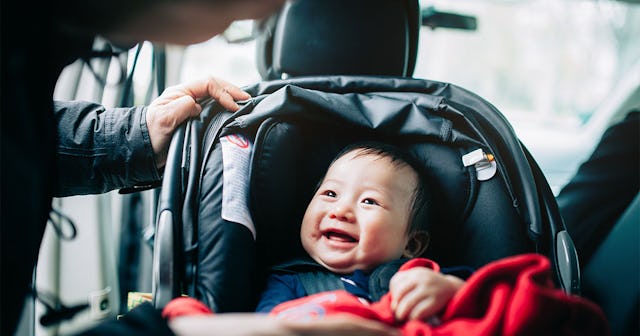I Know Why You Want To Use A Head Support In The Car Seat — But Don't Do It

When it comes to car seat safety, it may seem like there are just so many specific and bothersome rules. I remember when I was a new parent and my friend pointed out that my child’s car seat chest clip was too far down his chest. I was convinced she was overreacting and being too nit-picky. I felt like she was calling me a bad parent.
But then I did some research and realized she was exactly right. Chest clips help ensure that your child is positioned safely during a crash. Incorrectly placed chest clips can press against your child’s neck or organs during a crash and cause damage. So it makes sense that they should be placed in just the right spot. (By the way, that spot is in the center of their chest, in line with their armpits.)
Really, all the rules about car seat safety are like that—annoying specific, but absolutely necessary. Remember, our babies and young children are not adult size. Their bodies are vulnerable and still forming. We need to do everything we can to keep them safe in the car. After all, car crashes are a leading cause of death in children.
Since that incident all those years ago, when my friend corrected my child’s chest clip placement, I’ve learned a lot about car seats. I thought I pretty much knew it all until recently when I learned a new fact, which is that using any kind of added head support device (headbands/straps) in your child’s car seat is a big NOPE.
You can totally understand why parents want to do this. When your baby or young child falls asleep in the car, their head tends to flop to the side, or flops right down. It makes sense that you’d want some sort of device to keep their head in place. In fact, a quick Google search tells me that their head support devices are sold literally everywhere.
But they are patently unsafe. Please do not use these devices for your child.
There are two dangers that come with using a head support device. The first is positional asphyxiation, which is when your child’s airways are blocked because of the position of their body. The second is an increased risk of harm if your child is in a car crash.
Guido Mieth/Getty
As Dr. Alisa Baer (AKA, the car seat lady) points out, the head support devices that don’t come with your car seat typically have padding both around the head and behind the head. Padding behind the head actually can push your baby’s head down, which can make it difficult for them to breathe.
But what about those slumped down napping heads? As Dr. Baer explains, toddlers and older children don’t need any kind of head support, because if they are old enough to sit upright, they have the musculature to pick their head up if they fall asleep and have trouble breathing.
Dr. Baer says that for newborns, it’s healthy and normal for them to sleep with their head turned to the side, and that generally, they don’t need any sort of repositioning in their car seat. While any sort of purchased head positioner is a “no,” because of the danger of it pushing your baby’s head forward, Dr. Baer suggests that placed two rolled receiving blankets alongside (not behind) your baby’s head and body is an option (visit her website for instructions and photos).
In addition, simply following the instruction of keeping your baby’s car seat rear facing will support your baby’s head well, according to Erin Baughn, injury prevention specialist at Helen DeVos Children’s Hospital. She explained to TODAY Parents that a properly installed rear facing car seat is really all you need to keep your baby’s head safe and protected.
“It’s so important to make sure that the car seat is installed correctly and rear facing for those babies that don’t have that head control,” Baughn explained. “Rear facing car seats work phenomenally well.”
Baughn also discussed the second reason these devices are dangerous for children: restraining your child’s head movement in the car can make your child’s risk of injury in a car crash much more serious.
As Baughn explained to TODAY Parents: “If you restrain your child’s head … the car seat is no longer going to perform the way that the car seat manufacturers have designed it. Potentially, that child’s neck could actually separate from their spinal cord. We call that internal decapitation.”
Okay, that is absolutely terrifying. If that doesn’t convince you not to use one of these devices, I don’t know what will.
It’s actually really horrible that so many of these devices are sold everywhere, because most parents probably think they are fine to purchase and use. That’s why experts are sounding the alarm on this issue.
So if you are using one of these devices, stop doing so now. And if you see someone else using one, say something. Yes, I was annoyed at my friend for pointing out my kid’s incorrectly placed chest clips. But now I’m so grateful that she told me that, because from then on, my child was that much safer in the car.
It takes a village to raise a child and keep them safe, so please spread the world on this issue.
If you have any additional concerns about the installation or safety of your child’s car seat, you can take it to a car seat passenger safety technician for an inspection. These inspections are generally free. Go to Safe Kids to find a car seat safety technician near you.
This article was originally published on